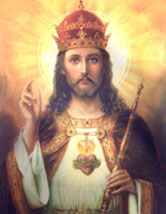Read about the first diocese dedicated to Our Lady of Perpetual Succour and how She rewarded its bishop with a miraculous cure. |
|
| |||||||||||
|
The Mysterious Story of the Icon of
|
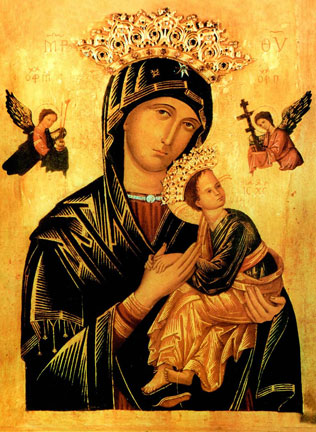 |
In a day in which the requests of Our Lady of Fatima are given short shrift, the intriguing history of the miraculous painting of Our Lady of Perpetual Help (or Perpetual Succour) is a salutary reminder that nothing can thwart the wishes of the Mother of God.
What Our Blessed Mother wants, Our Blessed Mother gets!
Early Miracles of Grace
There is probably not a Catholic today who is not familiar with the beloved image of Our Lady of Perpetual Help. Under this consoling title, chosen by Our Lady herself, She has granted countless spiritual and temporal favors to those who invoke her aid. It is as though God is using her miraculous picture to indicate that she is the Mediatrix of all Graces – and the way to His mercy, because, as St. Alphonsus tells us, “Mary’s prayers to God are the prayers of a Mother, and therefore are never refused.”[1]
Some believe that this picture is a copy of one painted by St. Luke, which was called the Hodegetria, Greek for “Leader of the Way”. However, comparisons of the two paintings and their histories suggest that the Perpetual Help is not a copy of St. Luke’s painting, but nevertheless similar to it. It also has associated with it the miraculous powers of the original Hodegetria, which seemingly perished in a siege of Constantinople in 1453. According to tradition, when Our Lady saw St. Luke’s painting, she blessed both him and the icon, promising, “My grace will accompany it.” That promise lives on in the picture of Our Mother of Perpetual Help and even in many of its reproductions.
St. Luke sent the Hodegetria to his friend and patron Theophilus in Antioch. In the middle of the fifth century, Eudocia, wife of Emperor Theodosius II of Constantinople, received it as a gift whilst touring the Holy Land. Eudocia sent the picture to her sister-in-law St. Pulcheria in Constantinople, who had the large church of Sancta Sophia erected as a shrine for this venerable relic.
The Hodegetria remained there for a thousand years, a period marked by striking miracles. It was venerated by innumerable Christians, rich and poor alike. Several times when Constantinople was threatened by barbaric invaders, through the prayers of the people at the shrine and in procession with the image, the city was spared. In one spectacular miracle in 718, while Saracens were besieging the city, the picture was carried in procession down to the sea and touched to the calm water. At once a violent storm arose, destroying the entire Saracen fleet.
Kidnapping Our Lady
We turn our attention now to the intriguing chronicle of how the picture of Our Lady of Perpetual Help came to Rome and its present home in the Church of St. Alphonsus, under the care of the Redemptorists. We are indebted for most of the historical facts to the book, The Miraculous Image of Our Mother of Perpetual Help, written by the American Redemptorist, Father Raymond J. Spitzer, in 1954.[2]
Devotion to the icon dates back centuries. It was first venerated in Crete, where it was known as Our Lady of the Angels,[3] perhaps because St. Michael and St. Gabriel are featured prominently in the picture. Painted on wood seemingly in the 13th or 14th century,[4] it is only about twenty inches high and sixteen inches wide, making it easy to transport.
In 1480 the picture was smuggled from Crete to Rome by a thief!
The story of this heist and its aftermath was written on a parchment affixed to a wooden tablet which hung in the Church of St. Matthew — the first Roman shrine for the icon — and later attached to the picture itself. It was written around 1499, the year the picture was enthroned in St. Matthew’s. The original document is no longer extant, but there are copies of it in the Vatican library, and so the mysterious story of how Heaven used thieves and kleptomaniacs to spread worldwide devotion to Our Lady of Perpetual Help has come down to our time.
The following is the text of this document, as cited by Fr. Spitzer:
A certain merchant, a native of Crete, stole this picture of the Virgin, which had worked many miracles in a church on that island. With the picture concealed among his wares, he boarded a ship and set out to sea. When a great storm arose, the sailors began to despair of their safety. Though they knew nothing about the picture, they prayed very fervently to God and to the Virgin to be saved. God heard their prayers.
A year later the merchant came to Rome, bringing the picture with him. There he was stricken with a malignant disease. Immediately he called to his bedside a Roman friend and asked him to care for him. The Roman took the merchant into his own home and did all he could to help him, but the disease continued to grow more violent.
Finally the dying man called his friend, and with tears in his eyes, begged him to fulfill his one last request. When the Roman promised to do whatever he was asked, the merchant divulged the entire story of the picture: how he had stolen it from a church where it was famous for miracles, how it could now be found among his effects. ‘Because of this, I beg you to put it in some church where there is a place more appropriate for such a picture.’
After the merchant’s death, the picture was found among his belongings, but the wife of the dead man’s friend prevailed upon her husband by her entreaties not to take the picture out of the house. Instead, she placed it in her bedroom and kept it there for nine months.
The Blessed Virgin, however, counselled the Roman in a vision not to keep the stolen picture, but to put it in some more honorable place. He neglected to do so. Some time later the Virgin returned and advised him as before, that he should not keep the picture in his house. He paid no attention to this request. Finally, the Virgin admonished him again, adding that if he did not take the picture to some church, he would die a miserable death. Now the Roman was frightened; the next morning he told the whole story to his wife and pleaded with her to donate the picture to some church. She replied that she was amazed he could make such silly statements. ‘Why, I am not an infidel, but a Christian! Besides, we are not the only ones who keep a picture like this in their home. No Christian is so wicked as not to have a picture of the Virgin, or of Christ crucified, or some other picture of this kind in his house!’ The Roman listened to his wife’s persuasive words.
The Virgin appeared a fourth time to the Roman and said, ‘Behold, several times I have warned you, and even tried to frighten you with threats, so that you might remove me from this place; but you would not listen to me. It is now necessary that you depart first so that I may thereafter find a more suitable abode.’ At that moment he was struck with a horrible disease and died.
The Virgin then appeared in a vision to the Roman’s six-year-old daughter and told her: ‘Go and admonish your mother and your grandfather, and say to them: Holy Mary of Perpetual Help commands you to take her out of your house; otherwise you will all die at once.’ The girl narrated the apparition to her mother, and the mother began to tremble, because she, too, had had a similar vision. She now realized that she had been the cause of her husband’s death, and she began to weep. At the same time she firmly resolved to remove the picture from her home.
But a neighbor woman, investigating her loud cries and tears, prevailed upon her to keep the stolen picture. ‘You are mistaken,’ the neighbor said. ‘It is foolish to believe such things. The Virgin is in heaven and does not care what we do with her painted pictures here below!’ For some reason she continued to heap insulting slurs upon the picture. When this neighbor returned home that evening, she was stricken with a serious disease, but on making a solemn promise to the Queen of Heaven, she was cured.
Finally the Blessed Virgin appeared for the second time to the little girl, commanding her to tell her mother to place her picture between St. Mary Major and St. John Lateran, in a church dedicated to St. Matthew the Apostle. The mother did as she was told, and sent for the Augustinian Fathers, who were in charge of that church. In the presence of the clergy and a large gathering of people they removed the picture to St. Matthew’s Church. On that same day the first public miracle occurred. A man so paralyzed in his right arm and side that he could scarcely move, humbly recommended himself to God and the Virgin, promised a votive offering and was instantly cured.
In this manner the picture of the most Blessed Virgin was enthroned in the above-mentioned church of St. Matthew the Apostle, on the 27th of March, 1499, in the pontificate of our most holy Father and Lord in Christ, of our Lord Pope Alexander VI, in the seventh year of his pontificate.
So the title "Our Lady of Perpetual Help" was chosen by our Blessed Mother herself, as was her picture’s home between the two venerable basilicas of St. Mary Major and St. John Lateran.
The Babylonian Captivity
The site of St. Matthew’s Church was on the Esquiline Hill, whose soil was sanctified by the blood of countless martyrs. Furthermore, the church had been erected on the site of the paternal home of St. Cletus, the third Pope. The basilicas themselves are located at either end of the Esquiline.
In keeping with the humility practised by Our Lady, exemplified by the simple home at Nazareth and the rough stable of Bethlehem, the house selected for her small image was a tiny church situated in a poor and isolated corner of Rome. Its exterior was built with rough-hewn stone and bricks of baked clay. The road in front of it, the Via Merulana, a bustling thoroughfare today, was then just a dusty footpath, impassable on rainy days. The adjacent Augustinian monastery also practised the rule of simplicity and poverty.
Then in 1517 Pope Leo X made St. Matthew’s a Cardinal titular church. Its Cardinal patrons renovated and improved the shrine. Copies of the Perpetual Help picture were painted outside the church and on the garden walls, and the interior was lavishly furnished. However, no one thought of enlarging the tiny chapel.
Nevertheless, the miraculous picture was visited by crowds of pilgrims from all walks of life and many nations. For three centuries St. Matthew’s Church was considered one of the most important pilgrimage sites in the world. That Our Lady kept her promise of help was evident from the numerous discarded crutches, written accounts of sudden cures, grateful thanksgiving notes, and offerings of jewellery and golden trinkets left near the altar above which the image rested.
But in 1798, the devil entered Rome. The army of Freemason Napoleon Bonaparte took over the seat of Christendom, proclaiming it “The Free Roman Republic”. The Pope, Pius VI, fled to Siena. He was captured by the French and imprisoned in Valence, France, where he died a year later.
Meanwhile, on June 3, 1798, Napoleon’s anti-religious governor of “Free Rome,” General Massena, commanded that thirty churches be destroyed “for strategic reasons.” The humble St. Matthew made the list. The devil obviously hoped to destroy devotion to the Blessed Virgin through her miraculous picture, a channel of grace and salvation.[5] In 1801, Pope Pius VII lamented that “hardly the slightest vestige” of St. Matthew’s remained. The picture was presumed to have perished with it.
However, unknown to the world, during the night of June 3rd, a small band of the monks had silently hastened half a mile up the Esquiline to the church and convent of St. Eusebius, formerly owned by the Celestine Fathers.[6] (Pope Pius VI had assigned this property to the Augustinians upon hearing of St. Matthew’s impending destruction.) Carried with them into “exile” was Holy Mary of Perpetual Help. Mary’s stay at the church of St. Eusebius, reverenced only by a few monks, was to last twenty-one years.
Because this community was very small for the large house at St. Eusebius, in 1819 the Pope assigned it to a smaller church and monastery, Santa Maria in Posterula, far across the city. There was already a picture of Our Lady in the church, so the Perpetual Help image was hung in the monastery chapel, where it remained until 1865, unknown to the public, its importance fading even from the memory of the monks.
In all, the Perpetual Help picture spent sixty-seven years in exile. Very fittingly this period has been called its “Babylonian Captivity” as it resembled the seventy years in which the captured Israelites dwelt in Babylon.
However, God intended devotion to His Blessed Mother to spread around the world to counteract the Protestant and Masonic evils that were endangering souls by leading them away from Mary. An amazing confluence of persons and events would now lead the Madonna out of exile and back to her chosen site between St. Mary Major and St. John Lateran.
Heaven-designed “coincidences”
The Augustinian community at St. Matthew’s in the 1700s had included a humble lay brother named Augustine Orsetti. His duties included house cleaning and manual labor. In keeping with Our Lady’s predilection for simple souls as her messengers, Brother Augustine was picked to start a chain of events that would bring her out of exile.
Brother Augustine spent much of his free time before the picture of Perpetual Help. He meditated on its mystical meaning and memorized the history of the picture which was indicated on the wooden tablet hanging nearby.
Nothing is known of his whereabouts after the monks fled the condemned monastery in 1798. However, in the early 1840s, more than 40 years later, he arrived at Santa Maria in Posterula – and to his great delight, discovered his beloved picture hanging above the high altar in the monastery chapel. Once again he could spend much time with his Queen and Mother as his duties included caring for the sacristy and cleaning the chapel.
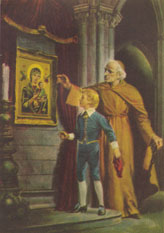 |
"Remember this picture, Michael!" |
Impressing upon the young student its importance, he would often anxiously exclaim, “See that picture, Michael? It’s old – very old. It used to be in the Church of San Matteo. Remember it!” Years later Michael would testify that these exhortations of the nearly-blind elderly brother mystified him.
The next step in God’s designs was the establishment of the Redemptorist headquarters in Rome. This was done at the command of Pope Pius IX because this Congregation, whose founder, St. Alphonsus de Liguori, was devoted to Our Lady, had by now spread around the world. After many fruitless attempts to find a suitable property, in 1855 the Congregation secured the large estate of Michael-Angelo Gaetano (or Cajetan), Prince of Caserta and Duke of Sermona. Called the Villa Caserta, it was located on the Esquiline Hill, along the Via Merulana – and it contained the ruins of a church.
The Redemptorists were completely unaware that they had purchased the land on which St. Matthew’s Church had stood about fifty years earlier! They completed their new church of St. Alphonsus on the Via Merulana in 1856. Little did they guess that the Saint’s toil for Our Lady would soon be rewarded with a singular honour for his church and his Congregation.
Meanwhile, former altar boy Michael Marchi joined the Redemptorists and was ordained in 1859.
That same year the Congregation discovered documents mentioning a renowned image of Our Lady at St. Matthew’s, whose ruins were on their property. One priest had noticed a picture of Our Lady painted on one of the ruin walls, but nobody knew if this was the image, or what it was called.
Imagine their great surprise when the newly-ordained Father Michael told the Fathers he knew the name of the picture and had seen it many times in the chapel of the Augustinian monastery of Santa Maria in Posterula, where it still resided. But the community did not pursue the matter further.
Triumphant return
In 1863 Our Lord gave the final push that would bring His Mother’s picture out of obscurity. That year a Jesuit priest who was giving public lectures on famous pictures of Our Lady in Rome also spoke of the Perpetual Help icon. He said it had disappeared for seventy years, and he feared this was because some ill-advised person was keeping it for himself in his own home. He asked that if any listener knew the picture’s whereabouts he would request the owner to make it available for public veneration once again in a church between the basilicas chosen by Our Lady.
When the Redemptorists at St. Alphonsus’ heard of the sermon, they realized that their church, located close to the ruined St. Matthew’s, was in the area designated by the Blessed Virgin. Was the picture meant to be venerated in their church? For nearly three years they prayed for guidance.
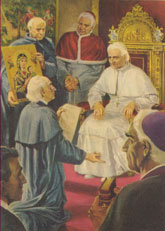 |
Testifying to Pius IX |
Finally, on December 11, 1865, the Superior General and Father Michael Marchi went to Pope Pius IX and recounted the history of the picture, emphasizing that St. Alphonsus’ Church was located exactly where Our Lady wanted her shrine. Pope Pius was highly interested in their recital because as a small boy he had once prayed before the painting in St. Matthew’s Church.[7]
Father Michael gave the Pope his written testimony, signed under oath. In it he stated that he had learnt about the picture from Brother Augustine Orsetti, at Santa Maria in Posterula. Brother Augustine had exhorted him to always remember it was the miraculous, highly-venerated icon from St. Matthew’s. Now it hung in the Santa Maria chapel, ignored and dusty. It was his fondest desire to have it publicly venerated in the location desired by the Blessed Virgin. Without hesitation, the Pope approved the request and ordered the picture to be sent to St. Alphonsus’ Church.
Father Michael’s document had been signed on the Feast of the Immaculate Conception – a date inspired by Heaven, because it was destined for the Pope who had proclaimed the doctrine of the Immaculate Conception just eleven years earlier.
On April 26th, 1866, Our Lady returned in triumph to her chosen home. The Perpetual Help picture was carried in solemn procession through the Esquiline region to St. Alphonsus’ Church. Houses along the route were gaily decorated with flowers and vines and festooned with banners, flags and bunting as the people joyously welcomed back their Mother.
The help of Our Blessed Mother was immediately felt. Several miracles took place during the procession, including the recovery of a four-year-old boy at the point of death from a brain ailment and fever. As the picture passed by their home, his mother held him at the open window and implored Our Lady to either cure him or take him to heaven. Within hours the boy began improving, and in a few days he was able to visit the shrine of Perpetual Help in thanksgiving for his cure.
[Related: The far-reaching effects of the procession on a British diocese, and the miraculous cure of its bishop.]
At the church, the picture was enshrined on the high altar and a solemn “Te Deum” of thanksgiving was sung. The church was profusely decorated with flowers and candles which burnt into the night.
Our Lady was honoured further by a special triduum at the shrine over the next three days. Each morning Mass was celebrated by a Cardinal. This was followed by the Litany of Our Lady, a sermon preached by a renowned Italian Redemptorist, and Benediction given by a Bishop. There were similar services in the evenings. Special indulgences were granted by Pope Pius to those attending the devotions, and large throngs filled the church for each service. Later, the Pontiff visited the shrine and granted a special blessing to all those who would pray before the miraculous picture.
It can still be visited today in the church of St. Alphonsus, located about a block away from St. Mary Major’s, on the Via Merulana. Now crowded in amongst shops and buildings, and behind large gateposts, the church does not easily catch the eye. Only a small mosaic of the Perpetual Help picture above its door indicates that it is the renowned shrine.
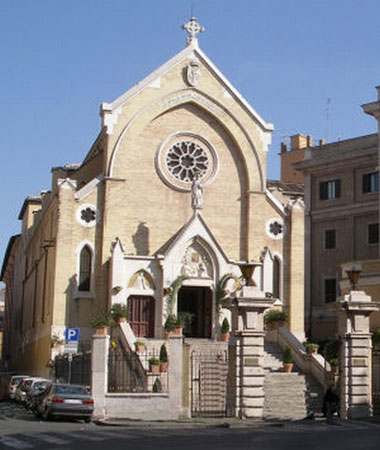 |
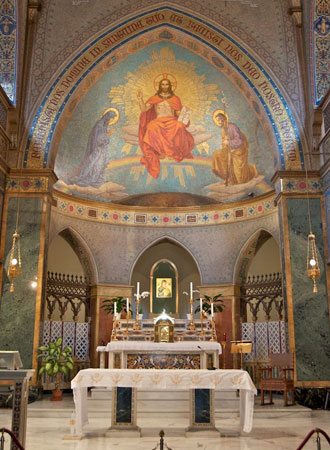 |
The Church of St. Alphonsus today |
Sanctuary of the Church of St. Alphonsus |
When Pope Pius IX assigned the image to the Redemptorists, he also gave them a commission: “Make Our Mother of Perpetual Help known throughout the entire world.” Although devotion to Our Lady of Perpetual Help pre-dated the Redemptorists in countries as far away as India, it is undoubtedly their apostolic zeal that has made her universally known and loved.
Many prayer leagues and Confraternities of Our Mother of Perpetual Help arose after the picture’s triumphant return, and an Archconfraternity enriched with indulgences, under the protection of St. Alphonsus, was inaugurated in 1876. At his request, Pope Pius IX was enrolled as its first member.
Today the most popular devotion is the public weekly or Perpetual Novena. All around the world crowds of people — even non-Catholics — flock to churches for these services. Copies of the picture, prayer cards and medals, as well as books and articles in many languages, have further spread the consoling message of Perpetual Help to countless millions of people.
Our Lady’s choice of St. Alphonsus and his Congregation as the propagators of her Perpetual Help was a seal of approval on his teachings, which beautifully harmonize with the miracles and message of the picture: Mary is our Mother and the dispenser of all God’s graces. In his outstanding work, The Glories of Mary, St. Alphonsus said that Mary’s “only thought, after seeking the glory of God, was to succor the miserable.”[8] She is the Mediatrix of all Graces.[9] He declared that “if the intercession of the saints, and especially that of Mary is good and useful, it is also good and useful always to obtain it.”[10]
“Among all the devotions to our Blessed Mother,” taught St. Alphonsus, “none pleases her so much as ... asking her help in each and every difficulty.... Mary certainly will help us if we have recourse to her by calling on her most holy name in which there is a marvellous power against the devil.”[11] He ardently desired to have Mary loved and praised by all men for the sake of their salvation.[12]
Because of her prompt and miraculous assistance to those who call on her, Our Mother of Perpetual Help has been loved and cherished for over 500 years.
PRAYER TO OUR MOTHER OF
PERPETUAL HELP
O
MOTHER OF PERPETUAL HELP, grant that I may ever invoke Thy most powerful name, which is the safeguard of the living and the salvation of the dying. O Purest Mary, O Sweetest Mary, let Thy name henceforth be ever on my lips. Delay not, O Blessed Lady, to help me whenever I call on Thee, for, in all my needs, in all my temptations I shall never cease to call on Thee, ever repeating Thy sacred name, Mary, Mary.
O what consolation, what sweetness, what confidence, what emotion fill my soul when I pronounce Thy sacred name, or even only think of Thee. I thank God for having given Thee, for my good, so sweet, so powerful, so lovely a name. But I will not be content with merely pronouncing Thy name: let my love for Thee prompt me ever to hail Thee, MOTHER OF PERPETUAL HELP.
Recite Nine Hail Marys.
To copy or print this prayer, click here.
For more prayers in honour of Our Lady of Perpetual Help, click here.
ENDNOTES
1. St. Alphonsus de Liguori, The Glories of Mary, ed. Rev. Eugene Grimm, CSSR (Brooklyn: Redemptorist Fathers, 1931; reprint ed., Brookings, South Dakota: Our Blessed Lady of Victory Mission, n.d.), p. 702.
2. Published by Perpetual Help Redemptorist Fathers, Liguori, Missouri.
3. The Perpetual Novena of Our Lady of Perpetual Help, a novena booklet for St. Michael’s Church, Bombay, 1982, p. 2.
4. “Our Mother of Perpetual Help,” www.marys-touch.com/history/olhelp.htm.
5. Cf. St. Alphonsus, p. 159: The devil “exerts himself to his utmost to destroy devotion to the Mother of God in souls; for if this channel of grace is closed, he easily gains possession of them.”
6. The remaining monks dispersed to other Augustinian houses.
7. “Our Mother of Perpetual Help.”
8. St. Alphonsus, p. 183.
9. Ibid., Chap. V.
10. Ibid., p. 702 (emphasis added). St. Alphonsus was expanding on the Council of Trent’s teaching: “It is good and useful earnestly to invoke the saints.”
11. From the Statutes of the Archconfraternity, as cited by Fr. Spitzer, p. 62.
12. St. Alphonsus, p. 616.
Originally published in Catholic Family News, July 2011.
Copyright © 2008-2025 Canisius Books. All rights reserved.
Users may download and print, or electronically distribute, this article or extracts for their own personal and non-commercial use only. For electronic distribution, this web page URL must be acknowledged by hyperlink:
https://canisiusbooks.com/our-lady-perpetual-help_icon.htm
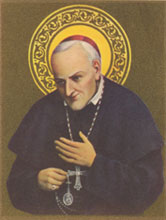 |
St. Alphonsus Liguori |
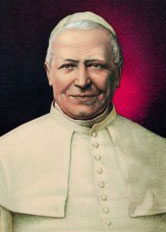 |
Blessed Pope Pius IX |
